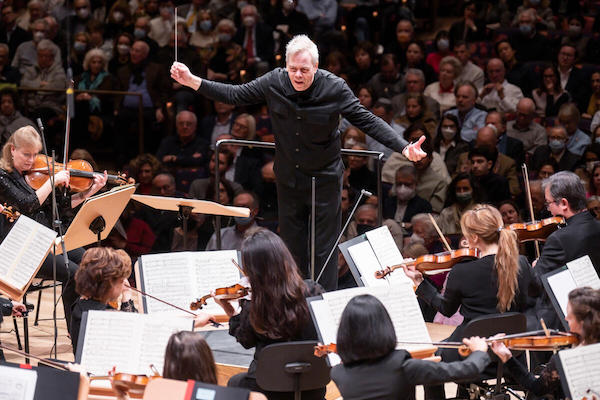Debutant Lintu leads Philharmonic in rare Bartók, flowing Sibelius
As an unusual mid-November warm spell ended in New York, a boreal chill settled over David Geffen Hall Wednesday night. For his debut with the New York Philharmonic, Finnish conductor Hannu Lintu brought wintry music by his compatriots Saariaho and Sibelius, as well as one of Stravinsky’s coolest works, Symphonies of Wind Instruments.
In the middle, like a campfire on a frosty night, burned Bartók’s Concerto for Two Pianos, Percussion and Orchestra, in an incandescent performance by pianists Daniil Trifonov and Sergei Babayan. The student-and-teacher duo was expertly partnered by three familiar figures usually seen in back of the orchestra, not in front: Philharmonic percussionists Christopher S. Lamb, Daniel Druckman and Markus Rhoten.
A lean, long-limbed presence on the podium, Lintu adapted visibly to each composer’s style, issuing clear instructions to execute Stravinsky’s objective vision, holding Saariaho’s fragile Ciel d’hiver in soft hands, and carving Geffen’s newly-curvy space with sweeping gestures in the Symphony No. 7 of Sibelius.
It’s a rare conductor who can make one see a timbre, but Lintu—who is chief conductor of the Finnish National Opera and Ballet—seemed to be doing just that as he shaped the intriguing object that is Stravinsky’s Symphonies. Squawking or burnished, thick or scrawny, the Russian master catalogued the endless ways woodwind and brass instruments can “sound together” (the root meaning of the word “symphony”).
Many a composer has ordered from this catalogue, including Copland for the widely spaced wind chords of his ballets and Stravinsky himself for the curly, twining woodwind lines in The Rite of Spring.
The composer criticized the work’s 1921 premiere performance—conducted by Koussevitzky, no less—as too “expressive.” No such problem Wednesday night, as Lintu and the adept Philharmonic players hung a piece of rigorously abstract modern art on Geffen’s wavy birch walls.
Bartók’s concerto comes with a family history: It originated as a chamber piece for the composer to perform with himself and his wife, Ditta Pásztory-Bartók, at the pianos, and two percussionists. The expanded version with orchestra was introduced in London by another husband-and-wife team, Louis Kentner and Ilona Kabos. The piece remains a favorite of married or sibling piano duos.

The relationship of teacher to pupil can be like family, perhaps even closer. Certainly warm feelings—if not always pinpoint synchronization–were evident on Wednesday between Trifonov and his former teacher at the Cleveland Institute of Music, Babayan, as they blazed through Bartók’s challenging score.
Although the three percussionists wielded a variety of instruments, one was most aware in the first movement of Rhoten’s hard-driving timpani, Druckman’s coruscating xylophone, and the artful shadings of Lamb’s snare drum. In its subsidiary role, the orchestra offered a cushion of string sound and brassy reinforcement at the climaxes.
The Lento, ma non troppo found Bartók in a characteristic nocturnal mood, its winding tune punctuated by soft bird calls in the pianos, yet even here single sparks from the xylophone pierced the darkness. The touches of humor that leavened the first movement retuned in force in the capricious finale, which darted between sudden stops and even found an attractive tune or two before closing, most unusually for a virtuoso concerto, with Lamb’s long snare-drum diminuendo to silence.
Babayan threw a paternal arm around his lanky, much taller pupil during their bows. Then the two returned to the pianos for a dizzyingly fast and funny encore, the closing movement of Mozart’s Sonata for Two Pianos in D major, K. 448.
The myth of Orion the hunter, condemned to wander the winter night sky for his violent pursuit of women and animals, inspired Kaija Saariaho’s large work Orion for orchestra, the middle movement of which now has a life of its own in concerts as Ciel d’hiver (Winter Sky).
As heard on Wednesday, the piece could have been the soundtrack for a night of gazing up at the cold, brilliant stars of winter. A lonely piccolo floated over a soft sparkle of strings and high percussion, to be joined by wind “symphonies” far more delicate than Stravinsky’s. The sad repetition of a descending three-note motive suggested both the pain of exile and the celestial sphere rotating inexorably in the vast night sky.
Brief crescendos cut through the scene like sudden rays of light, or comets flying by. Conductor Lintu brought the piece to a close as rapt and still as its beginning.
Sibelius was contemplating the winter of his life in 1923, when he distilled his symphonic style into one through-composed work that was so unconventional in form that he hesitated to call it a symphony. But to quell speculation about the work’s “program” he went for the generic title in the end, and “Sibelius’s Seventh” has remained a perennial on concert programs.
With Virginia Woolf and James Joyce writing their revolutionary novels around the same time, the idea of “stream of consciousness” was in the air when the Finnish composer penned this continuous piece that falls into three, four, or eleven sections, depending on which analyst you ask.
Lintu emphasized not divisions but flow, coaxing an orchestral “sunrise” out of pianissimo darkness, digging into sonorous strings, asking for and getting billows of golden brass tone. The music danced, argued, and flirted by turns. A favorite texture was brass over strings—sounding lonely in a soft breeze at first, but later driven toward the piece’s climax by urgent string energy.
Sensing each moment as part of a continuum, the Finnish maestro swept it all forward, pausing only briefly in Saariaho-like celestial realms before swelling in a sudden crescendo to the end.
The program will be repeated 7:30 p.m. Thursday, 11 a.m. Friday and 8 p.m. Saturday. nyphil.org.







